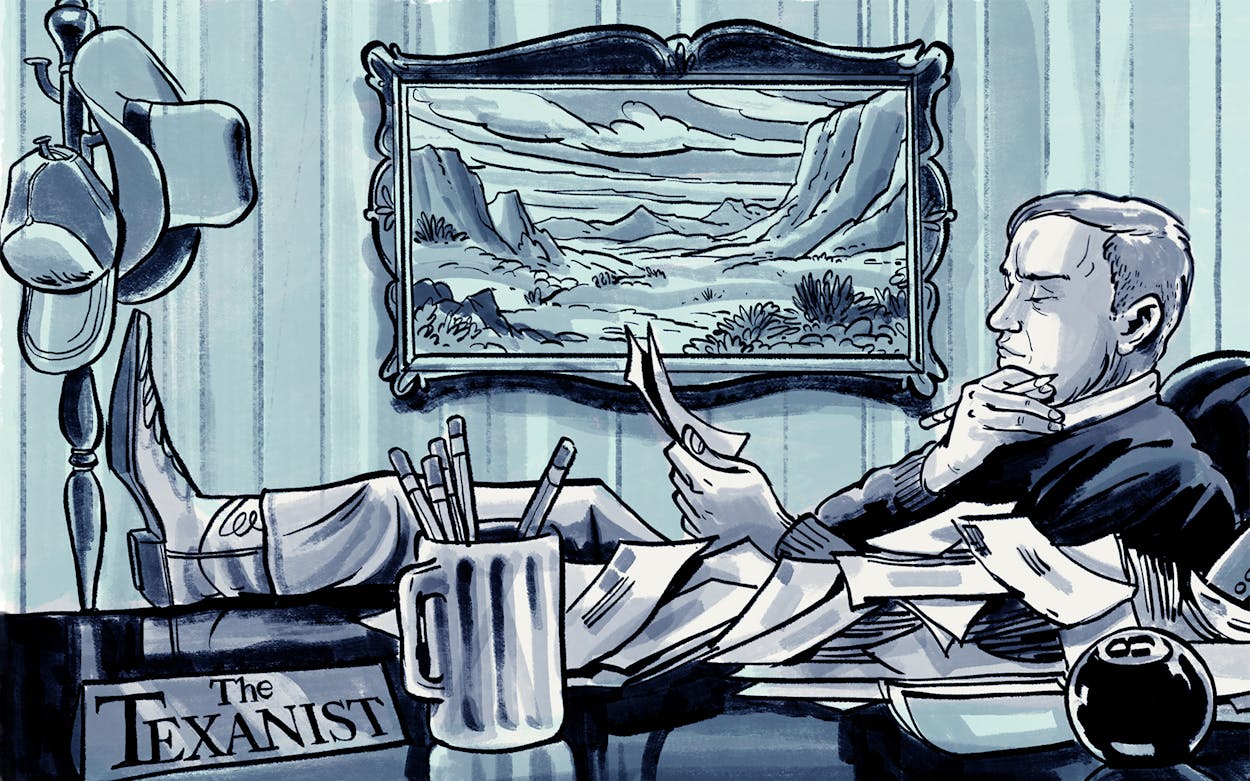Q: Although I have lived in Dallas County since 1960, I am really a native East Texan. People often ask me which part of East Texas I’m from. “Kaufman? Tyler? Longview? Rusk?” they’ll say. Sometimes I’m even asked if it’s Paris, Athens, or Palestine. “No,” I tell them, “I’m from Hemphill, in Sabine County, Deep East Texas.” But where is East Texas, really? Is it anywhere from east of Dallas to northeast of Houston? Or could it just be a state of mind, like New York?
Robert Sewell, Ed.D., Dallas County
A: If the Texanist has ever read a sentence pertaining to East Texas that ended with the words “like New York,” he doesn’t remember it. In fact, this may be the first time such a sentence has ever been written. Congratulations, Dr. Sewell. That said, the Texanist has been to both New York and East Texas and can report with as much confidence as he’s ever summoned up while reporting anything in his whole long life that those two places are not at all alike. But the Texanist does see what you’re trying to say with the “state of mind” comparison, even though he’s not really much of a Billy Joel fan. And he doesn’t disagree with you. East Texas and New York are both unique places that exist on a physical as well as a metaphysical sort of plane.
Your query about the physical part of that equation—“Where is East Texas?”—reminds the Texanist of a letter he received back in November 2013 from a woman with a similar question about the regionalization of the state, although that lady’s main concern was the whereabouts of West Texas. The Texanist is relieved to say that what he told the writer of that letter all those years ago still holds true today: “The nomenclature attached to the state’s different regions can be confusing.” Texas has been sliced up by so many geographers, both amateur and professional, that it’s sometimes said that the state boasts seven physical regions (Big Bend Country, Gulf Coast, Hill Country, Panhandle Plains, Piney Woods, Prairies and Lakes, South Texas Plains) and other times that there are only four (Gulf Coastal Plains, Interior Lowlands, Great Plains, Basin and Range Province). Others will apply simpler, somewhat less academic and more familiar terms (West Texas, East Texas, Deep East Texas, “Behind the Pine Curtain,” South Texas, Central Texas, North Texas, the Panhandle, etc.). What is a Texan to make of such a dizzying assortment of regions, subregions, and nether regions? (“Nether regions? Really?” No, the Texanist just wanted to make sure you were paying attention.)
In the course of answering the “Where’s West Texas?” question, the Texanist relayed an easy-to-use rule of thumb that has long served him well in ascertaining whether he was visiting East Texas or West Texas: If you take a moment to look around and see that there are numerous tall trees, you are probably not in West Texas. And if you stop and look around and see broad scenic vistas, you are probably not in East Texas. Not bad, huh? (As a side note, the Texanist feels compelled to note that once, after having had a particularly weird dream in which he was named lead judge of the Southern Hush Puppy Championship at the annual Texas State Forest Festival in Lufkin, he attempted to formulate another “Am I in West/East Texas?” test having to do with the quality of restaurant hush puppies. Alas, the research that was required to construct the test was as bad for the Texanist’s midsection as the test itself was at telling him where he was.)
But a guide alerting you to where East Texas is not doesn’t really answer the question you’ve posed, which, if the Texanist recalls, was “Where is East Texas?” Additionally, one could reasonably argue that there is no definitive answer to your question. As pretty much any denizen of Big Bend Country, the Gulf Coast, Hill Country, the Panhandle Plains, or the Piney Woods, etc. could tell you, the various lines of demarcation separating Texas’s various regions are pretty fuzzy.
That caveat notwithstanding, it is nonetheless fairly well accepted that the greener, damper, and more humid part of the state known as “East Texas” is separated from the other parts of the state by just such a fuzzy line, this one running from the Red River in north central Lamar County (Paris) southwest to east central Limestone County (Groesbeck) and then south and east toward Galveston Bay (Harris and Chambers counties). Anything that lies east of that line and west of our borders with Arkansas and Louisiana can pretty safely be referred to as East Texas, though whether that fuzzy line passes east of, west of, or right smack through the middle of Houston will be argued from now until the end of time.
The Texanist hopes this helps you find your place in the world.
Have a question for the Texanist? He’s always available here. Be sure to tell him where you’re from.
A version of this is published in the June 2018 issue.
- More About:
- The Texanist
- Hemphill









